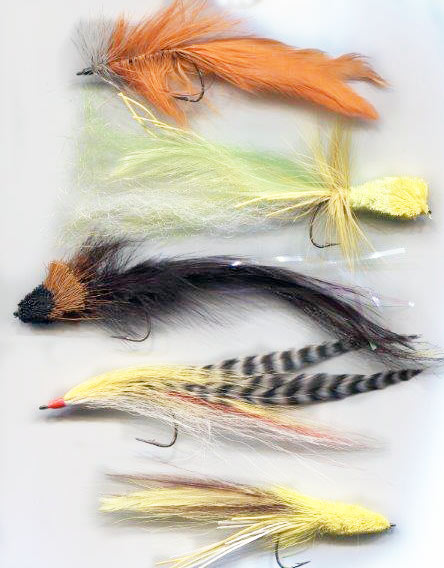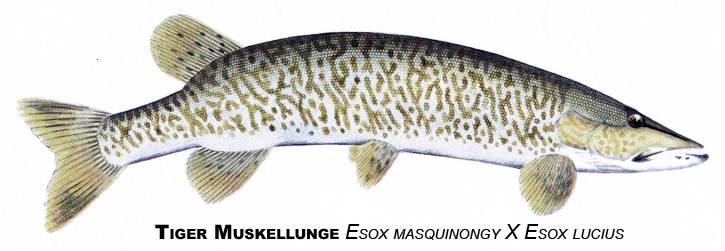Tiger Muskellunge, July 2013, Fish of the Month!
Tiger Muskellunge
Esox masquinongy X Esox lucius
Local Names:
Tiger muskie
Average Size:
20 to 36 inches
3 to 10 pounds
Distinguishing Field Marks:
Color and color pattern are reliable distinguishing field marks for this species. (See the illustration.)
-
The Tiger muskellunge is a hybrid of the Muskellunge and the Northern pike. It maintains characteristics of both parent species, but generally shows more pronounced bars on its sides than does the pure Northern pike and more diagonal or horizontal markings on its cheeks and gill covers than Muskellunge.
-
The caudal fin is deeply forked, but its tips are more rounded than those of the Muskellunge.
 North American Range:
North American Range:
Map to the right shows approximate range in North America.
Diet:
The same as that of both parent species, a short period of invertebrate consumption changing quickly to a diet of fish, which later includes anything that passes their way, including birds, reptiles, amphibians, and mammals.
Fly Fishing for Tiger Muskellunge:
Look for this fish usually living in the same protected shallow water habitats where you would find either of its parent species.
 Take powerful 7 to 9 weight outfits when you go in search of these fish. As “fruit doesn’t fall far from the tree,” Tiger Muskies continue the feeding habits of their original parent species. For the fly-fisher, the benefits of this hybridization is that its offspring take on enough Northern pike characteristics to make them both less solitary and less difficult to provoke into striking than are pure Muskies. The large weed-proofed, often brightly colored flies and surface poppers recommended for Northern pike fishing should produce good results.
Take powerful 7 to 9 weight outfits when you go in search of these fish. As “fruit doesn’t fall far from the tree,” Tiger Muskies continue the feeding habits of their original parent species. For the fly-fisher, the benefits of this hybridization is that its offspring take on enough Northern pike characteristics to make them both less solitary and less difficult to provoke into striking than are pure Muskies. The large weed-proofed, often brightly colored flies and surface poppers recommended for Northern pike fishing should produce good results.
Look for Tiger Muskies in typical pike habitats; primarily near and around lake or river bed structures. Weed beds, blow-downs, and rocky outcroppings are all good suggestions regarding where to begin your hunt for these fish.
Light wire or heavy monofilament leader tippets are almost a necessity for fly rod landing Tiger Muskellunge. Boats, canoes, float tubes, kayaks, etc. are also, in most locations, necessary to accessing these fish. Some suggested flies at right.
Again, crossed between two similar parent species, Tiger Muskies fight anglers’ attempts to bring them to hand with powerful runs and occasional head-shaking jumps.
As always, for those new to this species-specific branch of the fly-fishers’ possible quarry, an internet search will produce plenty of information about prime locations, and state, regional, and local regulations.
Significance to Humans:
This is a species recently developed and introduced specifically for sport fishing. There are those who regard the Tiger Muskellunge as an unwanted intruder and those who find it a welcome addition to their fishing opportunities. The choice is yours.
Status:
Maintained exclusively through hatchery stocking programs.







